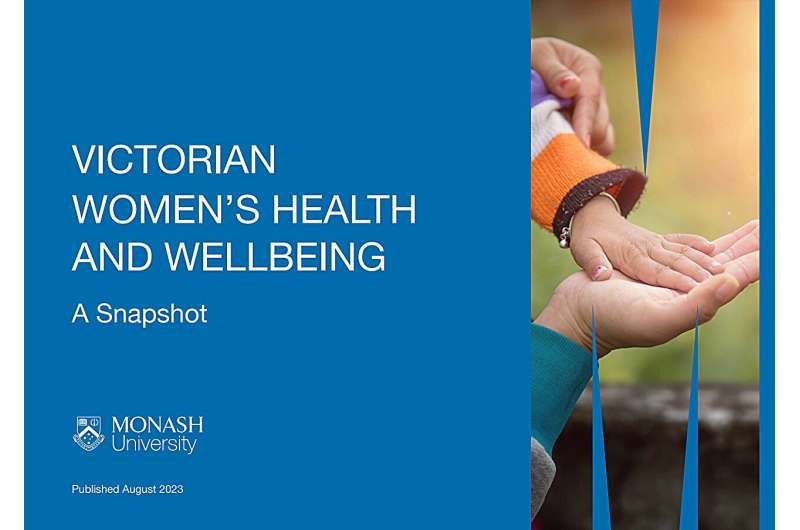This article has been reviewed according to Science X's editorial process and policies. Editors have highlighted the following attributes while ensuring the content's credibility:
fact-checked
trusted source
proofread
Report: Victorian women lag behind men in health, well-being and income

Victorian women lag behind men on key health and well-being indicators, a new Monash University-led report has found.
The Victorian Women's Health and Well-being Snapshot found Victorian women's health was worse in every dimension relative to men.
Produced by the Monash Center for Health Research and Implementation (MCHRI), Monash University, it revealed that Victorian women reported declining health over time and poorer health compared to men.
Around two thirds of women reported poor physical health, physical functioning, low levels of vitality and poor mental health/mental functioning. Caring responsibilities also significantly and disproportionately limited women's opportunities for full time employment.
It is based on the representative data from the annual Household, Income and Labor Dynamics in Australia (HILDA) survey.
The report is co-authored by MCHRI's Director Professor Helena Teede, leading women's health expert and health economist Professor Emily Callander, and big data and biostatistician lead, Associate Professor Joanne Enticott.
Professor Teede said an urgent conversation was needed on the declining health and well-being of Victorian women, linked to inequity. She said good health including physical and mental health, meaningful employment and a decent level of income allowed individuals to fully participate in and contribute to society.
"The opportunity for meaningful employment and a decent level of income allows individuals to contribute to society and to optimize health and well-being," Professor Teede said.
Professor Callander said low income and under employment were two primary determinants of poor health, and Victorian women lagged behind men in both.
"This report shows that more Victorian women are employed part time, or are underemployed than men," Professor Callander said.
"It also shows the significant annual income and superannuation gap between men and women in Victoria, which is directly related to access to health care and to adverse health outcomes."
The Victorian report found that overall, the percentage of Victorian women in full time employment was 18.6 percentage points lower than men, with only 27.4% working full time.
Far more women than men were working part-time and were not in the labor force at all.
There was also a $23,008 annual income gap between men and women in Victoria and a $53,062 superannuation gap from the recent national survey data in 2020.
The Victorian report follows the first Australian Women's Health and Well-being Scorecard: Towards equity for women. The national report found that at current rates it will take 70 years to reach full time employment equality with men, and more than 200 years to reach income equity.
Associate Professor Joanne Enticott said that addressing women's mental health is critical.
"In mental health and emotional well-being, some of the biggest gender health gaps are evident with over eight percentage points more women reporting mental health issues. In no other section of health would we tolerate such a big gender difference. Economic outcomes are clearly linked with well-being and mental health, so by addressing economic differences we can start to start to close the mental health gender gap."




















